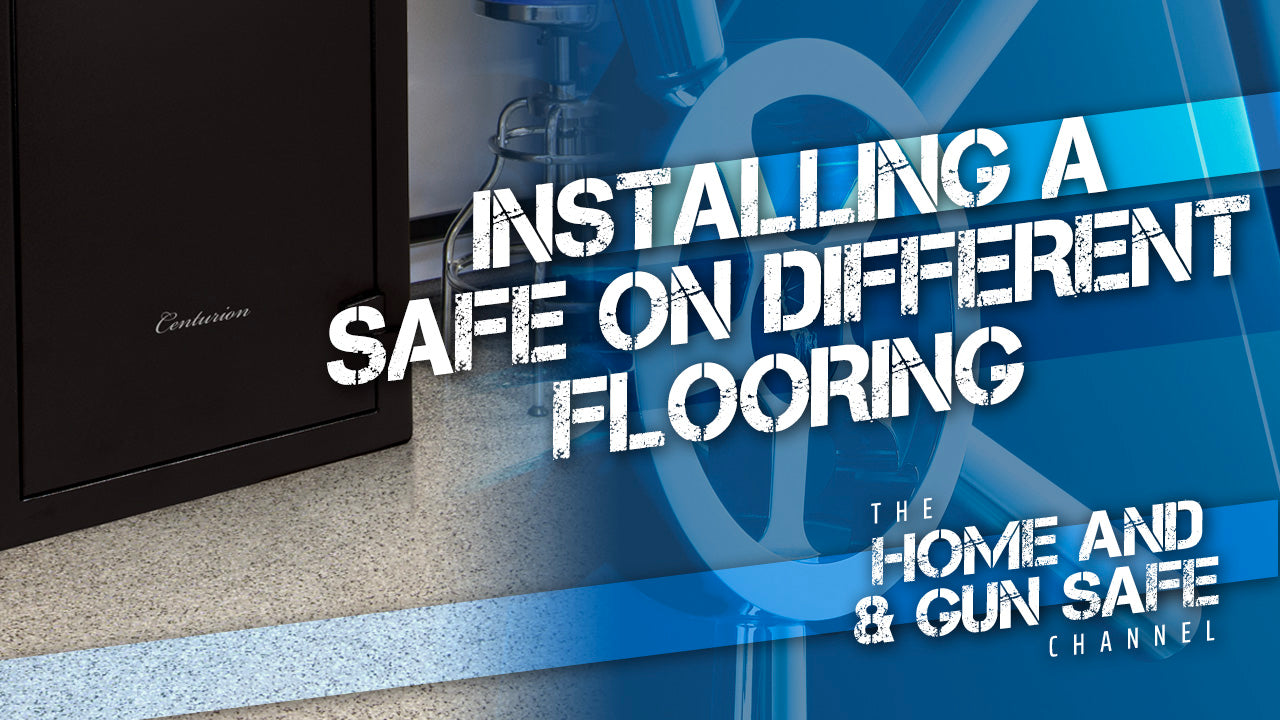Installing Your Safe on Carpet, Concrete, or Tile
Anchoring down a gun safe is one of the easiest ways to help keep thieves from tipping it over and prying it open. It involves using bolts and/or anchors to firmly secure it to your floor. It sounds straightforward, but let’s take a look at why anchoring is so important, and how different flooring types determine how it should be done.
Should You Anchor Your Gun Safe
The short answer: yes. Absolutely. Definitely. All the time, no exceptions. Bolting your safe down prevents thieves from being able to tip it over and attempt prying it open. It’s MUCH easier to bust open a safe that is on its back!
Things to Consider
Drill a couple holes, put in some anchors, and boom, added security, right? Not exactly. How a safe is anchored depends both on the type of flooring you have AND the type of subflooring. For example, If you have a basement or crawlspace, subfloors on the main level are generally plywood with joists underneath for support. Those will require wood anchors. If you don’t, or if your safe is going in your basement, you'll likely need concrete anchors.
An Important Note to Remember: This job could and would be much easier for, and is best left to, a professional. Installing a safe on your own can be dangerous and cause damage to your new safe, your home, and yourself. We ALWAYS recommend having a professional install your safe. For more info on what to expect from a professional install, watch this video.
How to Anchor a Gun Safe to Softer Floor
Anchoring a gun safe on hardwood, carpeting, vinyl, linoleum, or laminate installed on top of a wood subfloor requires a safe-anchoring kit for wooden subfloors. To directly bolt your safe down, find the pre-cut anchoring holes in your safe. Most full-sized safes come with them, and they’re typically in the floor. Lift the floor panel of your safe and remove the floor caps to find the pre-cut anchoring holes.
- Drill the appropriate-sized hole in your floor in each of the four anchoring locations.
- Place the kit’s washers on the anchor bolts.
- Using a socket set, secure the bolts in the drilled holes.
- Replace the floor caps and floor panel.
How to Anchor a Gun Safe to Harder Floors
Anchoring your Liberty gun safe on a concrete subfloor is a little more complicated. You’ll need an anchoring kit designed specifically for concrete, along with a hammer drill to drill through the concrete. Before you start drilling, be absolutely sure your concrete floor is not a post tension type. These slabs have strong steel cables running through them that are under thousands of pounds of pressure. It’s dangerous if a cable is damaged because it can immediately snap out of the concrete and may damage property or injure anyone nearby. Your floor should have a stamp on it telling you if it’s a post-tension floor, but if you’re not sure, talk to the contractor who built your home.
- Remove the safe’s floor panel and floor caps to find the pre-cut anchoring holes.
- Drill a hole in the concrete floor at each of the four anchoring locations with a hammer drill.
- Clean any dust out of the holes.
- Hammer the concrete anchors into the holes.
- Install the bolts and tighten them with a socket set.
Can You Anchor a Safe Through Tile or Stone?
It’s definitely possible to place a safe on tile or stone flooring. Stone in particular is strong, and as long as the safe’s weight is evenly distributed, it shouldn’t crack your stone. Most tiles can handle the weight of a gun safe, but you can check the Porcelain Enamel Institute’s guidelines to make sure your tile is tough enough to hold a safe.
Anchoring a safe to stone or tile, however, is another story. Most safe installation experts don’t recommend anchoring to these types of floors. It’s nearly impossible to anchor a safe on tile squares without cracking them. So, if you want your safe on tile, talk to your installer about the possibility of anchoring your safe to the wall rather than through your floor.
Does Liberty Delivery & Install Safes?
Yes! Curbside delivery is offered by our network of professional dealers. In-home installation (including stair carry) may be available in your area. You can click over to our dealer finder to choose a dealer near you, then discuss delivery and installation options with them!
Learn more about how to keep a gun safe from damaging your floor by clicking here.
Transcript of Video: How to Install a Gun Safe
Hey guys! Robert here with the home and gun safe channel. Anchors are for boats… and for safes? Let’s check this out.
Personally, I like it when my safe stays in one place, so thank goodness for anchors! Anchoring down a gun safe involves using bolts and/or anchors to firmly secure it to your floor. Seems pretty straightforward, but let’s take a look at why anchoring is so important, and how different flooring types determine how it should be done.
The short answer: yes. Absolutely. Definitely. All the time, no exceptions.
Bolting your safe down prevents thieves from being able to tip it over and attempt prying it open. It’s MUCH easier to bust open a safe that is on its back!
Drill a couple holes, put in some anchors, and boom, added security, right? Well, not exactly. How a safe is anchored depends both on the type of flooring AND the type of subflooring - the stuff underneath your floor. That all needs to be taken into consideration before installation. For example, If you have a basement or crawlspace, subfloors on the main level are generally plywood with joists underneath for support. Those will require wood anchors. If you don’t, or if your safe is gonna be in your basement, you'll likely need concrete anchors.
Note, this job should, could and would be MUCH easier, and is best left to, a professional. Installing a safe on your own can be dangerous and cause damage to your new safe, your home, and yourself. Still, it’s not bad to know how to do it yourself.
Anchoring a gun safe on hardwood, carpeting, vinyl, linoleum, or laminate installed on top of a wood subfloor requires a safe-anchoring kit for wooden subfloors. To directly bolt your safe down, find the pre-cut anchoring holes in your safe. Most full-sized safes come with them, and they’re typically in the floor. Lift the floor panel of your safe and remove the floor caps to find the pre-cut anchoring holes.
Drill the appropriate-sized hole in your floor in each of the four anchoring locations.
Place the kit’s washers on the anchor bolts.
Using a socket set, secure the bolts in the drilled holes.
Replace the floor caps and floor panel.
Anchoring your Liberty gun safe on a concrete subfloor is a little more complicated. You’ll need an anchoring kit designed specifically for concrete, along with a hammer drill to drill through the concrete. And before you start drilling, be absolutely sure your concrete floor is not a post tension type. These slabs have strong steel cables running through them that are under thousands of pounds of pressure. It’s dangerous if a cable is damaged because it can immediately snap out of the concrete and may damage property or injure anyone nearby. Your floor should have a stamp on it telling you if it’s a post-tension floor, but if you’re not sure, talk to the contractor who built your home.
Here’s how to anchor your safe to concrete:
Remove the safe’s floor panel and floor caps to find the pre-cut anchoring holes.
Drill a hole in the concrete floor at each of the four anchoring locations with a hammer drill.
Clean any dust out of the holes.
Hammer the concrete anchors into the holes.
Install the bolts and tighten them with a socket set.
It’s definitely possible to place a safe on tile or stone flooring. Stone in particular is strong, and as long as the safe’s weight is evenly distributed, it shouldn’t crack your stone. Most tile can handle the weight of a gun safe, but you can check the Porcelain Enamel Institute’s guidelines to make sure your tile is tough enough to hold a safe.
Anchoring a safe to stone or tile, however, is another story. Most safe installation experts don’t recommend anchoring to these types of floors. It’s nearly impossible to anchor a safe on tile squares without cracking them. So, if you want your safe on tile, talk to your installer about the possibility of anchoring your safe to the wall rather than through your floor.
A safe that is anchored is going to stay put and be less likely to get broken into. This is an easy way to boost your safety AND your security. Have any other means of “bonus security” you can think of? Let us know in the comments below, click that subscribe button, and as always, catch ya later!







